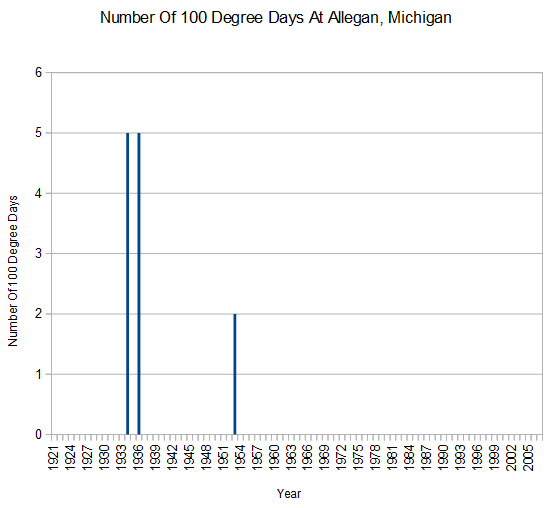Someone was trying to blame the high incidence of 100 degree readings during the 1930s on time of observation bias.
Allegan, Michigan took their readings at midnight during the 1930’s, and showed the same pattern as the rest of the stations. One hundred degree readings during the 1930’s and 1950’s – and none since. The 1930s were the hottest on record in the US, and attempts to hide this are dishonest.



Allegan, Michigan, is such a wonderful little town. I lived in Kalamazoo in 2000-2002 (i.e. just at the beginning of the pause after the hottest period in the history of ever) and spent quite a bit of time working in Allegan. I seem to remember having far greater concerns regarding getting there safely during winter than concern regarding summer heat. The memory could be fuzzy, but I seem to remember that anything in the 90s was unusually hot.
I lived in KZ (Portage) 1980-2001. Day’s considered really hot were in the low 90’s. You’d get a few of those strung together and I seem to recall a few higher 90’s heat waves and a few Category Black days during Reserve 2-week ADT’s at Grayling. The first couple of years I heard “this is not a normal winter” and “this is not a normal summer” so I decided that they didn’t have normal weather and enjoyed whatever came.
But under the new communist regime the pas doesn’t matter only the present.
And the reference to support your claim, Tony……?
That is the USHCN daily data for Allegan, Michigan.
Instead of relying on arbitrary Tmax/Tmin ( for an arbitrary 24 hour time reference), NOAA required that all reporting stations report hourly temperatures 24x7x365. After 30 years, one reporting station would have transmitted 262800 hourly reports. No need for a TOB adjustment, as it would just have hundreds of thousands of hourly reports which it can then slice and dice. Things like diurnal changes, seasonal variations, etc… would show up in the data. No need to adjust.
Talk about your smoking guns. Excellent find Tony!
The Dust Bowl during the 30’s is described as being caused my bad farmland practices and severe high temperatures. If you search the internet there are numerous articles on the causes, all downplay the main reason, the severe high temperatures, but they do mention them. Yet we are being led to believe the temps of today are far hotter then they were during the 30’s. This is utter BS. Same goes for Greenland , where hardy Vikings once settled and grew crops where none will grow today as it is too cold and then there is the proclamations of unprecedented melting of glaciers never before witnessed in human history until the retreating ice uncovers hunting paraphernalia from ancient hunters not so long ago. The last standing card propping up this house of cards is the claim of unprecedented rise in temperatures in recent history using Weather Station Data from the last 100 years. Recent revelations in the methodology used to generate this apocalyptic history is based more on wishful thinking then actual science. When will the adults return to the room and take charge once again. The kiddies have had their play time.
It does not matter what time the unprecedent heat was recorded. The 1930’s heat was obviously far more extreme than anything over the last 60 years.
So no reply from Tony hahahaha predictable I say.
From Bill I mean
Eliza, as you know, we all have multiple names and personalities so it is easy to get confused! 🙂
Is it not equally possible that some claimed one time of observation reading s were taken in the a.m.? Could this not just as easily have produced a cool bias?